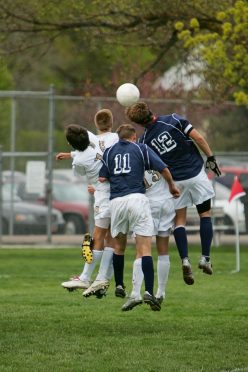Scott Vermillion likely wished to be remembered as one of the top defenders in Major League Soccer but, instead, the late player will be known as the first professional soccer player diagnosed with a condition associated with blows to the head.
Until the announcement that the brain of Vermillion, who died from acute alcohol and prescription drug poisoning at age 40 in 2020, showed evidence of chronic traumatic encephalopathy (CTE), the condition had typically been associated with sports like hockey, football and boxing. In the past two decades, CTE has been discovered in the brains of more than 300 professional football players.
But, research is still emerging in soccer, and Stephanie Alessi-LaRosa, MD, a sports neurologist with Hartford HealthCare’s Ayer Neuroscience Institute, cautioned players, parents and coaches against assuming erratic behavior is connected to CTE. The degenerative brain disease is thought to cause such symptoms as memory loss, depression and aggressive or impulsive behavior, but she stressed that not all mental health concerns are the result of play-related injuries.
“I have patients who are hesitant to get psychiatric treatment because they think they have CTE and are doomed,” she told the New York Times. “I think it’s important for patients to get the help they need, and if their family is concerned, get them to a sports neurologist.”
The reason, she explained, is that there is no cause and effect association between head injuries and personality changes and, ultimately, CTE, which is only diagnosed post-mortem.
“Some patients I see would rather explain their symptoms with their head injury history as it may lessen the stigma around mental health issues,” Dr. Alessi-LaRosa said. “There is nothing we can do about head injuries that already happened, and there are many factors involved in developing a psychiatric condition, not just head injuries.”
To date, she said there is no clear understanding of why some athletes, like Vermillion, get CTE and others do not. Research has not clearly laid out a cause and effect relationship between head injuries and personality changes in life and CTE
“I encourage people to continue playing the sports they love as the benefits still outweigh the risks,” said Dr. Alessi-LaRosa, adding that she supports the 2015 U.S. Soccer ban on heading in games and practices for players under the age of 10 and restrictions on heading in practice for older players.
Players or parents who are concerned about their health should speak to a sports neurologist, a physician who specializes in the neurologic injuries stemming from engaging in formal or informal athletic activities.
“There are many treatments available to those who seek help regardless of whether their condition stems from head injuries or something else. This is very important because we want to treat patients during their life instead of letting them worry about a diagnosis that may only come after their death,” Dr. Alessi-LaRosa said.
Vermillion, a high school and college all-American, played four seasons of professional soccer before retiring due to a recurrent ankle injury. His family reported that his final years were spent withdrawing into substance abuse and behaving erratically.



